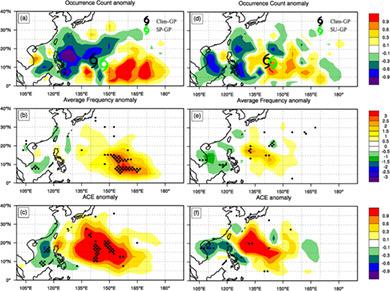当前位置:
X-MOL 学术
›
Int. J. Climatol.
›
论文详情
Our official English website, www.x-mol.net, welcomes your
feedback! (Note: you will need to create a separate account there.)
How does the onset time of El Niño events affect tropical cyclone genesis and intensity over the western North Pacific?
International Journal of Climatology ( IF 3.5 ) Pub Date : 2021-05-28 , DOI: 10.1002/joc.7227 Mei Liang 1, 2, 3 , Jianjun Xu 1, 2 , Johnny C. L. Chan 3 , Chunlei Liu 1, 2 , Hua Xu 1, 2
International Journal of Climatology ( IF 3.5 ) Pub Date : 2021-05-28 , DOI: 10.1002/joc.7227 Mei Liang 1, 2, 3 , Jianjun Xu 1, 2 , Johnny C. L. Chan 3 , Chunlei Liu 1, 2 , Hua Xu 1, 2
Affiliation

|
Previous studies have shown that the equatorial Pacific Ocean warming can be separated into spring (April~June; SP) and summer (July~October; SU) modes based on the onset time of El Niño events. Different onset times are caused by different atmospheric and oceanic conditions, which, in turn, should influence tropical cyclone (TC) activity. While the location of TC formation in the western North Pacific (WNP) shifts significantly eastward and equatorward in the SP type relative to climatology (1951–2017), only an eastward shift occurs in the SU type. Only intense TCs (category 1 + 2 + 3 and 4 + 5) have an obvious eastward and equatorward shift in the SP type, with no such shift in any TC category in the SU type. The number of category 4 + 5 TCs in the SP type increases significantly, but fewer category 1 + 2 + 3 TCs in the SU type. In the SP type, TCs are generally stronger, with more in category 4 + 5, and longer life spans occurring across all categories. However, no obvious change in TC intensity can be identified except for category 1 + 2 + 3 in the SU type. The eastward and equatorward shift of the mean genesis position in the developing phases of SP can be attributed to a southeastward shift of favourable atmospheric and oceanic conditions, which include weaker zonal vertical wind shear, stronger relative vorticity, higher mid-level relative humidity, and enhanced upper-ocean temperature (5–100 m). All these conditions are mainly related to the onset time of the westerly anomalies near the central equatorial Pacific. These results suggest that the onset time of El Niño events could serve as a good forecasting indicator for TC genesis position and intensity over the WNP.
中文翻译:

厄尔尼诺事件的发生时间如何影响北太平洋西部热带气旋的形成和强度?
已有研究表明,根据厄尔尼诺事件的发生时间,赤道太平洋变暖可分为春季(4~6月;SP)和夏季(7~10月;SU)两种模式。不同的开始时间是由不同的大气和海洋条件引起的,这反过来又会影响热带气旋(TC)的活动。相对于气候学(1951-2017),北太平洋西部(WNP)的TC形成位置在SP类型中显着向东和赤道移动,但在SU类型中仅发生向东移动。只有强 TC(1+2+3 和 4+5)在 SP 型中有明显的东移和赤道移动,在 SU 型的任何 TC 类别中都没有这种移动。SP 型中 4+5 类 TC 数量显着增加,但 SU 型中 1+2+3 类 TC 数量减少。在 SP 类型中,TC 通常更强,4 + 5 类更多,所有类别的寿命都更长。然而,除了 SU 类型中的 1 + 2 + 3 类之外,没有发现 TC 强度的明显变化。SP 发展阶段平均成因位置的东移和赤道移动可归因于有利的大气和海洋条件向东南移动,包括纬向垂直风切变较弱,相对涡度较强,中层相对湿度较高,以及增强的上层海洋温度(5-100 m)。这些情况主要与赤道中太平洋附近西风异常的发生时间有关。这些结果表明,厄尔尼诺事件的发生时间可以作为西太平洋热带气旋发生位置和强度的良好预测指标。
更新日期:2021-05-28
中文翻译:

厄尔尼诺事件的发生时间如何影响北太平洋西部热带气旋的形成和强度?
已有研究表明,根据厄尔尼诺事件的发生时间,赤道太平洋变暖可分为春季(4~6月;SP)和夏季(7~10月;SU)两种模式。不同的开始时间是由不同的大气和海洋条件引起的,这反过来又会影响热带气旋(TC)的活动。相对于气候学(1951-2017),北太平洋西部(WNP)的TC形成位置在SP类型中显着向东和赤道移动,但在SU类型中仅发生向东移动。只有强 TC(1+2+3 和 4+5)在 SP 型中有明显的东移和赤道移动,在 SU 型的任何 TC 类别中都没有这种移动。SP 型中 4+5 类 TC 数量显着增加,但 SU 型中 1+2+3 类 TC 数量减少。在 SP 类型中,TC 通常更强,4 + 5 类更多,所有类别的寿命都更长。然而,除了 SU 类型中的 1 + 2 + 3 类之外,没有发现 TC 强度的明显变化。SP 发展阶段平均成因位置的东移和赤道移动可归因于有利的大气和海洋条件向东南移动,包括纬向垂直风切变较弱,相对涡度较强,中层相对湿度较高,以及增强的上层海洋温度(5-100 m)。这些情况主要与赤道中太平洋附近西风异常的发生时间有关。这些结果表明,厄尔尼诺事件的发生时间可以作为西太平洋热带气旋发生位置和强度的良好预测指标。











































 京公网安备 11010802027423号
京公网安备 11010802027423号